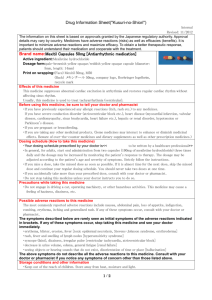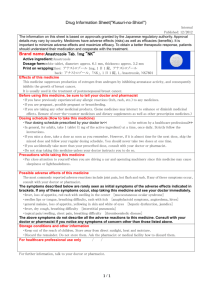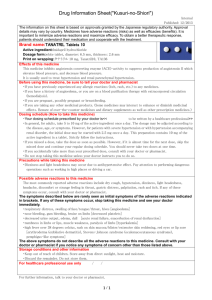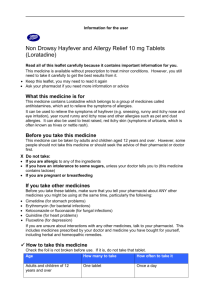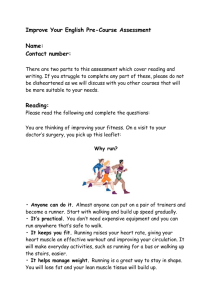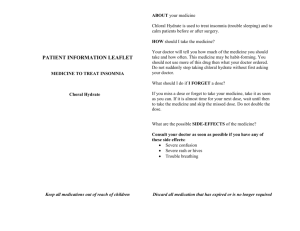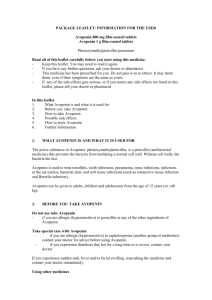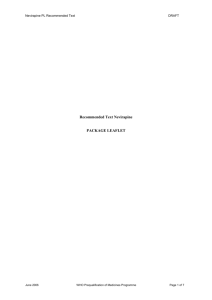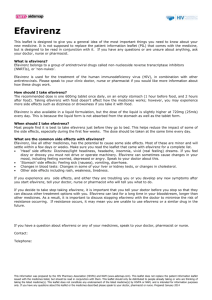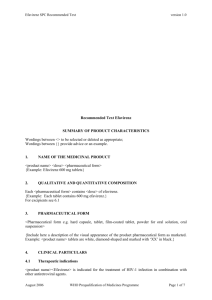PL-efavirenz - World Health Organization
advertisement
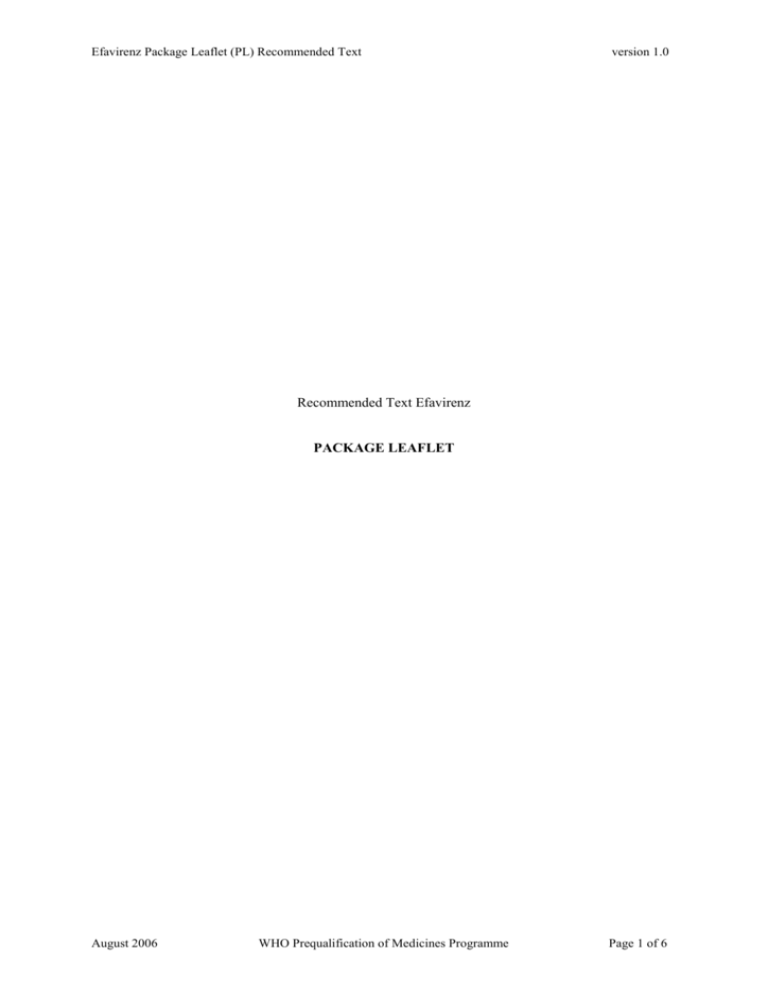
Efavirenz Package Leaflet (PL) Recommended Text
version 1.0
Recommended Text Efavirenz
PACKAGE LEAFLET
August 2006
WHO Prequalification of Medicines Programme
Page 1 of 6
Efavirenz Package Leaflet (PL) Recommended Text
version 1.0
PACKAGE LEAFLET: INFORMATION FOR THE USER
{(Invented) name strength pharmaceutical form}
Efavirenz
Read all of this leaflet carefully before you start taking this medicine.
Keep this leaflet. You may need to read it again.
If you have any further questions, ask your doctor or pharmacist.
This medicine has been prescribed for you. Do not pass it on to others. It may harm them, even
if their symptoms are the same as yours.
In this leaflet:
1.
What <product name> is and what it is used for
2.
Before you take <product name>
3.
How to take <product name>
4.
Possible side effects
5.
How to store <product name>
6.
Further information
1.
WHAT <PRODUCT NAME> IS AND WHAT IT IS USED FOR
<product name> belongs to a group of antiviral medicines, also known as antiretrovirals, called nonnucleoside reverse transcriptase inhibitors (NNRTIs). These are used to treat Human
Immunodeficiency Virus (HIV) infection.
<product name> is used in antiretroviral combination therapy for the treatment of HIV infection.
<product name> reduces the amount of HIV virus in your body and keeps it at a low level. It also
increases CD4 cell counts. CD4 cells are a type of white blood cell that plays an important role in
maintaining a healthy immune system to help fight infection. Response to treatment with <product
name> varies between patients. Your doctor or health care provider will be monitoring the
effectiveness of your treatment.
<product name> may improve your condition, but it is not a cure for your HIV infection. HIV
infection is a disease spread by contact with blood or sexual contact with an infected individual.
Treatment with <product name> has not been shown to reduce the risk of passing HIV infection on to
others by sexual contact or by blood transfer. Therefore, you must continue to take appropriate
precautions to avoid giving the virus to others.
During your treatment, other infections linked to your weakened immunity (opportunistic infections)
may arise. These will require specific and sometimes preventive treatment.
2.
BEFORE YOU TAKE <PRODUCT NAME>
Do not take <product name> if:
you are allergic (hypersensitive) to efavirenz or any of the other ingredients of <product
name>.> (see section 6, What <product name> contains);
Take special care with <product name>
Before using this medicine, you should have told your doctor or health care provider:
- if you suffer from liver disease (such as hepatitis);
- about past or present medical problems including allergies, seizures, mental illness, or substance
or alcohol abuse.
A mild-to-moderate skin rash commonly develops in the first two weeks after starting with <product
name>, this usually resolves within 4 weeks of the beginning of treatment; in case of a progression to
August 2006
WHO Prequalification of Medicines Programme
Page 2 of 6
Efavirenz Package Leaflet (PL) Recommended Text
version 1.0
a severe rash you need to tell your doctor or health care provider immediately and <product name>
may have to be discontinued.
Following the start of <product name> central nervous system side effects are very common, usually
starting in the first week of treatment. These may include dizziness, confusion, insomnia, somnolence,
impaired concentration and abnormal dreaming. Other side effects are amnesia, hallucinations,
euphoria or psychosis. These usually resolve within four weeks of the start of treatment.
<In some patients with advanced HIV infection (AIDS) and a history of opportunistic infection, signs
and symptoms of inflammation from previous infections may occur soon after anti-HIV treatment is
started. It is believed that these symptoms are due to an improvement in the body's immune response,
enabling the body to fight infections that may have been present with no obvious symptoms. If you
notice any symptoms of infection, please inform your doctor or health care provider immediately.>
You will need to take {product name} every day. This medicine helps to control your condition, but it
is not a cure for HIV infection. You may continue to develop other infections and other illnesses
associated with HIV disease. You should keep in regular contact with your doctor or health care
provider. Do not stop taking your medicine without first talking to your doctor or health care provider.
Taking other medicines
Please tell your doctor, health care provider or pharmacist if you are taking or have recently taken any
other medicines, including medicines obtained without a prescription like vitamins or nutritional
supplements. These may affect the action of {product name}, or {product name} may affect their
action.
medicines that cannot be taken with <product name> include astemizole, cisapride, terfenadine,
midazolam, triazolam, pimozide, bepridil and ergot alkaloids (for example, ergotamine,
dihydroergotamine, ergonovine, and methylergonovine). Taking these medicines with <product
name> may cause serious and / or life-threatening side-effects;
also herbal preparations containing St John’s wort (Hypericum perforatum) must not be taken
with <product name>;
<product name> significantly decreases levels of amprenavir, atazanavir, indinavir, lopinavir, and
saquinavir but increases levels of nelfinavir and ritonavir. Therefore, if <product name> is given
with either of these drugs, dosage adjustments of either may be necessary or alternatively ritonavir
boosting may be necessary. Efavirenz does not alter the levels of fos-amprenavir or tipranavir.
Ritonavir significantly increases levels of efavirenz.
<product name> should not be used as part of a triple combination regimen consisting of
efavirenz, didanosine and tenofovir because of inferior efficacy compared to other combination
regimens;
if you are treated with methadone when you start taking <product name>, your doctor or health
care provider may have to adjust your dose of methadone;
if you are taking the antibiotic clarithromycin, your doctor or health care provider may consider to
give you another antibiotic; if you are taking rifampicin, your doctor or health care provider will
prescribe a higher dose of <product name>;
if you are treated with atorvastatin, pravastatin, or simvastatin (lipid-lowering medicines, also
called statins) when you start taking <product name>, your doctor may need to adjust your dose of
the statin;
<product name> increases levels of ethinyl estradiol, barrier contraception (for example a
condom) should always be used in combination with other contraceptive methods.
Taking <product name> with food and drink
<product name> should be taken on an empty stomach or with a low-fat meal
Pregnancy
Inform your doctor immediately if you are pregnant or intend to become pregnant. If you are pregnant,
you should take <product name> only if you and your doctor decide it is clearly needed.
August 2006
WHO Prequalification of Medicines Programme
Page 3 of 6
Efavirenz Package Leaflet (PL) Recommended Text
version 1.0
Malformations have been seen in foetuses from animals and in newborns of women treated with
<product name> during pregnancy; therefore, pregnancy should be avoided in women receiving
<product name>. If you are a woman receiving <product name>, a reliable form of barrier
contraception (for example a condom) should always be used, with other methods of contraception
including oral (pill) or other hormonal contraceptives (for example implant, injection).
Breast-feeding
You should not breast feed your baby if you are taking <product name>.
Driving and using machines
Dizziness, impaired concentration, and drowsiness have been reported during treatment with <product
name>. If you experience these symptoms you should avoid potentially hazardous tasks such as
driving or operating machinery.
Important information about some of the ingredients of <product name>
<product specific>.
3.
HOW TO TAKE <PRODUCT NAME>
Always take {product name} exactly as your doctor or health care provider has told you. You should
check with your doctor, health care provider or pharmacist if you are not sure.
The usual daily dose for <adults is 600 mg> < adolescents whose body weight is > 40 kg is 600 mg,>
given once daily. <Since <product name> is a fixed dose tablet, <product name> is not suitable for
patients whose body weight is less than 40 kg. In these cases another formulation should be used e.g. a
smaller tablet, powder or liquid.>
<product name> should be taken on an empty stomach or with a low-fat meal e.g. in the evening
before going to bed.
<<product name> will always be taken in combination with other antiretroviral medication; please
make sure to follow the instructions within the supplied package leaflet.>
If you take more <product name> than you should
If you take too much <product name> consult your doctor or local first aid hospital.
If you forget to take <product name>
Try not to miss a dose. If you do miss a dose, take the next dose as soon as possible, but do not double
the next regular dose.
If you stop taking <product name>
{product specific}
<If you have any further questions on the use of this product, ask your <doctor> <or> <pharmacist>.>
4.
POSSIBLE SIDE EFFECTS
Like all medicines, <product name> can cause side effects, although not everybody gets them. If any
of the side effects gets serious, or if you notice any side effects not listed in this leaflet, please tell
your <doctor or health care provider> <or> <pharmacist>.
The most frequently reported adverse reactions associated with <product name> in combination with
other anti-HIV medicines include rash, dizziness, nausea, headache and fatigue.
The most notable unwanted effects are skin rash and nervous system symptoms that include dizziness,
insomnia, somnolence (drowsiness), impaired concentration and abnormal dreaming.
August 2006
WHO Prequalification of Medicines Programme
Page 4 of 6
Efavirenz Package Leaflet (PL) Recommended Text
version 1.0
You should consult your doctor if you have a rash, since some rashes may be serious; however, most
cases of rash disappear without any change to your treatment with <product name>. <Rash was more
common in children than in adults treated with <product name>>.
Very common reported (greater than 1 in every 10 patients treated) side effects are rash, dizziness,
confusion, insomnia, somnolence, impaired concentration, abnormal dreaming and changes in fat
metabolism as shown by increase in fasting triglycerides, total cholesterol, high- and low-density
lipoprotein cholesterol in blood.
Commonly reported (greater than 1 in every 100 patients treated) side effects are disturbed liver
function as detected by elevation of liver enzymes in blood, anxiety, depression, and excessive
development of the breast in the male (gynecomastia).
The following side effects are uncommon (between 1 in 1,000 and 1 in 100 patients treated): psychosis
(increased likelihood in those with history of psychiatric disease).
< Combination antiretroviral therapy may cause a condition called lactic acidosis, which is a build up
of lactic acid in the body, that can cause dehydration and coma which have been reported on rare
occasions in patients taking NRTIs . Deep, rapid breathing, drowsiness, and non specific symptoms
such as nausea, vomiting and stomach pain, may indicate the development of lactic acidosis. >
Combination antiretroviral therapy may cause changes in body shape due to changes in fat
distribution. These may include loss of fat from legs, arms and face, increased fat in the abdomen
(belly) and other internal organs, breast enlargement and fatty lumps on the back of the neck ('buffalo
hump'). The cause and long-term health effects of these conditions are not known at this time.
Combination antiretroviral therapy may also cause raised lactic acid and sugar in the blood,
hyperlipaemia (increased fats in the blood) and resistance to insulin.
If any of the side effects gets serious, or if you notice any side effects not listed in this leaflet, please
tell your doctor, health care provider or pharmacist.
5.
HOW TO STORE <PRODUCT NAME>
[For storage conditions statements see Appendix III]
Keep out of the reach and sight of children.
<Do not store above ºC>. <Store in the original <container><carton>>
Do not use <product name> after the expiry date which is stated on the <label> <carton> <bottle>
<...> <after {abbreviation used for expiry date}.> <The expiry date refers to the last day of that
month.>
<Do not use <product name> if you notice {description of the visible signs of deterioration}.>
<Medicines should not be disposed of via wastewater or household waste. Ask your pharmacist how to
dispose of medicines no longer required. These measures will help to protect the environment.>
6.
FURTHER INFORMATION
What <product name> contains
The active ingredient(s) is (are)…
The other ingredient(s) is (are)... <product specific>
August 2006
WHO Prequalification of Medicines Programme
Page 5 of 6
Efavirenz Package Leaflet (PL) Recommended Text
version 1.0
What <product name> looks like and contents of the pack
<product specific>
Prequalification Holder and Manufacturer
{Name and address}
<{tel}>
<{fax}>
<{e-mail}>
For any information about this medicinal product, please contact the local representative of the
Prequalification Holder:
{COUNTRY}
{Name}
<{Address}
{Town} {Postal code} – Country>
Tel: + {Telephone number}
<{e-mail}>
{COUNTRY}
{Name}
<{Address}
{Town} {Postal code} – Country>
Tel: + {Telephone number}
<{e-mail}>
This leaflet was last approved in {MM/YYYY}.
Detailed information on this medicine is available on the World Health Organization (WHO) web site:
http://www.who.int/prequal/ .
August 2006
WHO Prequalification of Medicines Programme
Page 6 of 6

